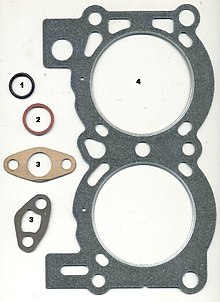Siamesed cylinders are engine cylinders arranged in such a way that they have no channels between them to allow water or other coolant to circulate.[1][2]


Cylinders are generally arranged in this manner when the engine block is of limited size or when stability of the cylinder bores is of concern, such as in racing engines.[3] The advantage is that the engine block will be reduced in size, or the bore can be increased in size. The disadvantage is a higher temperature between two cylinders, requiring a stronger engine block to avoid distortion of the metal, and better gasket sealing between the two bores.[1]
Related articles (example engines with siamesed cylinders)
- Chevrolet Stovebolt engine
- Chevrolet small-block engine (first- and second-generation)#4.125 in bore family (1970–1980)
- Oldsmobile 403 small-block V8 (1977-1979)
- Ford Godzilla engine
- Ford Racing versions of the Ford (Windsor) small block engine
- Honda B engine
- Mazda E engine
- Honda K engine
- Toyota A series of engines (including both performance engines like the 4age and small economy engines like the 3A, 4A)
References
edit- ^ a b Wright, Gus (2021). Fundamentals of Medium/Heavy Duty Diesel Engines. Jones & Bartlett Learning. ISBN 978-1-284-15091-9.
- ^ Principles of automotive vehicles. Department of the Army. 1985.
- ^ Baechtel, J. (2012). Competition Engine Building: Advanced Engine Design and Assembly Techniques. CarTech, Incorporated. p. 31. ISBN 9781934709627. Retrieved 2014-10-05.